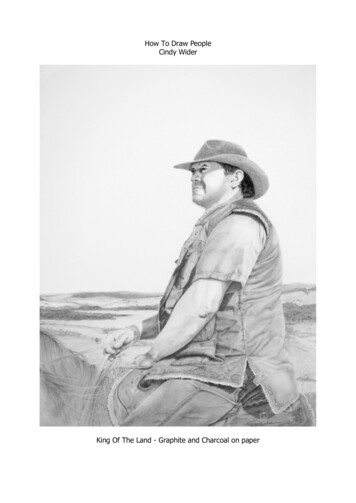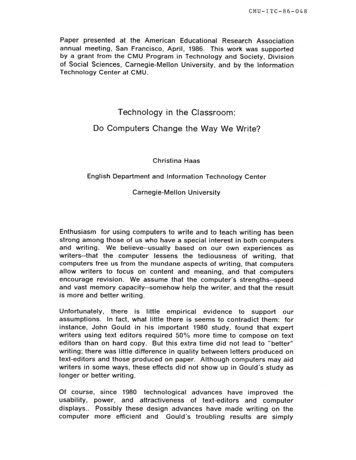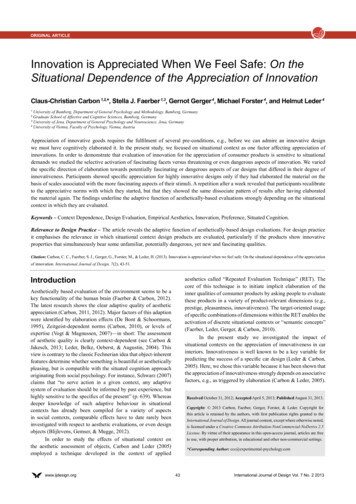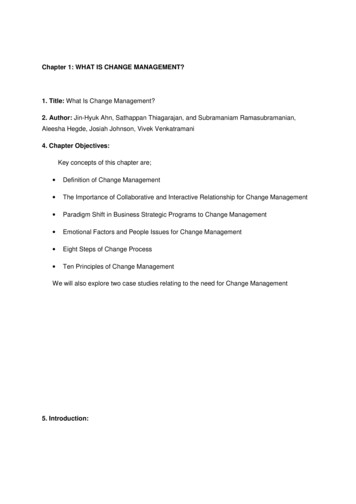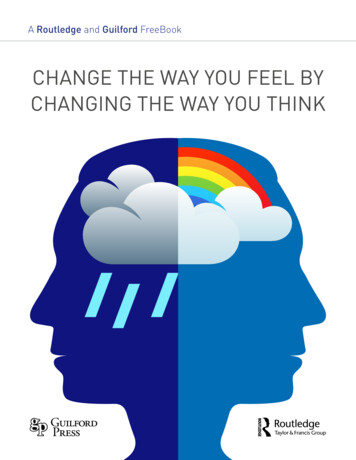
Transcription
A Routledge and Guilford FreeBookCHANGE THE WAY YOU FEEL BYCHANGING THE WAY YOU THINK
TABLE OF CONTENTS3 :: INTRODUCTION7 :: 1. IT’S THE THOUGHT THAT COUNTS(Chapter 3 from Mind Over Mood by Dennis Greenberger and Christine A. Padesky)19 :: 2. STARTING OUT AND HOW TO KEEP GOING IF YOU FEEL STUCK(Chapter 1 from Overcoming Depression and Low Mood by Chris Williams)37 :: 3. UNDERSTANDING FEAR AND ANXIETY(Chapter 1 from Worry Less, Live More by Susan M. Orsillo and Lizabeth Roemer)56 :: 4. DECIDE IF CBT IS FOR YOU(Chapter 1 from How to Get the Most Out of CBT by Windy Dryden)64 :: 5. DEPRESSION, UNHAPPINESS AND EMOTIONAL DISTRESS(Chapter 2 from Mindful Way Workbook by John Teasdale, J. Mark G. Williams, and Zindel Segal)75 :: 6. CONNECTING TO OTHERS AND MANAGING YOUR EMOTIONS(Chapter 8 from Letting Go of Self-Destructive Behaviors by Lisa Ferentz)82 :: 7. THE INVENTION OF THE EXPRESSIVE WRITING APPROACH(Chapter 2 from Opening Up by Writing It Down by James W. Pennebaker and Joshua M. Smyth)96 :: 8. HAPPINESS: AN OVERVIEW(Chapter 1 from Understanding Happiness by Mick Power)
INTRODUCTIONFeel happier, calmer, and gain the confidence to make changes that can help youlive the life you want with a new FreeBook from Routledge and Guilford Press. Thishighly practical resource contains a multitude of tips and exercises from bestsellingCognitive Behavioral Therapy (CBT) and positive psychology titles, including Mind OverMood; Worry Less, Live More; and Overcoming Depression and Low Mood Workbook.Featuring easy-to-implement strategies and advice to change negative thoughtpatterns and behaviour, this FreeBook will provide valuable help to those dealing withstress, anxiety, and depression.Guilford Press is an independent publisher of books, periodicals, software, and DVDsin mental health, education, geography, and research methods. Guilford Press isdistributed in the UK and Europe by Taylor & Francis. To order in other countries, visitwww.guilford.com.CHP 1: IT’S THE THOUGHT THAT COUNTS:In this chapter from the bestseller, Mind Over Mood, Dr. Dennis Greenberger andDr. Christine Padesky explore the connection between our thoughts and how theyinfluence our mood and behaviour.“Most people who are anxious, depressed, or angry can tell youthat “just thinking positive thoughts” is not that easy Lookingat a situation from all sides and considering a wide range ofinformation – positive, negative, and neutral – can lead to morehelpful ways of understanding things and new solutions todifficulties you face.”CHP 2: STARTING OUT AND HOW TO KEEP GOING IF YOU FEEL STUCKHow do you help yourself to plan for and overcome blocks to change? Chris Williamsprovides valuable tips, exercises and advice for using self-help resources in thischapter from Overcoming Depression and Low Mood.“You can’t expect to be able to swim immediately. You may needto start at the shallow end and practice at first. Pace what you doand don’t jump straight away into the deep end”ROUTLEDGE AND GUILFORD PRESS3ROUTLEDGE.COM GUILFORDPRESS.CO.UK
INTRODUCTIONCHP 3: UNDERSTANDING FEAR AND ANXIETYWritten by Susan M. Orsillo and Lizabeth Roemer, this insightful chapter from WorryLess, Live More unpacks fear, anxiety, stress and worry, providing the reader withpractical exercises and tips to help explore and control emotional responses.“Although we are saying that fear and anxiety are a naturalpart of life, we are not suggesting that you “grin and bearit.” We have found that by understanding anxiety, noticing itsmany components as it evolves, learning to relate to anxietydifferently.and clarifying what is important, people can makesignificant changes.”CHP 4: DECIDE IF CBT IS FOR YOUAuthor Windy Dryden outlines the main features of cognitive behavioural therapy andexplains how and why it can be a beneficial form of therapy. This chapter from Howto Get the Most Out of CBT also provides invaluable advice about choosing the righttherapist.“It is often thought that CBT therapists are not interested in yourpast. This is not correct, and in CBT you may talk about whateverit is you are bothered about, be it your past, your present oryour future.”CHP 5: DEPRESSION, UNHAPPINESS AND EMOTIONAL DISTRESSWhy do we get stuck in a negative cycle? This chapter from The Mindful Way Workbookwill help readers gain a better understanding of how unhappiness and our stateof mind can contribute to depression, as well as advice on how to break free fromthis cycle.“But, somehow, most of us don’t feel able to let things taketheir natural course—when we feel sad or unhappy, we feelwe have to do something, even if it’s only trying to understandwhat’s going on. Paradoxically, it is those very attempts to getrid of unwanted unhappy feelings that get us stuck in everdeepening unhappiness.”ROUTLEDGE AND GUILFORD PRESS4ROUTLEDGE.COM GUILFORDPRESS.CO.UK
INTRODUCTIONCHP 6: CONNECTING TO OTHERS AND MANAGING YOUR EMOTIONSIn Letting Go of Self-Destructive Behaviors, Lisa Ferentz offers creative resources andbehavioural techniques that calm the body, manage negative thoughts, and addresstension and anxiety. The purpose of this chapter is to focus on the impact of negativeexperiences and relationships and how to manage negative emotions and createpositive connections“Attaching to people you love lets you feel protected, safe,physically comforted and soothed, and connected to others.”CHP 7: THE INVENTION OF THE EXPRESSIVE WRITING APPROACHLeading experts James W. Pennebaker and Joshua M. Smyth talk about the originand development of the expressive writing approach. This chapter from Opening Up byWriting It Down explores the health benefits of this therapy and includes instructionson how to practice expressive writing.“ people who wrote about their deepest thoughts and feelingsrelated to stressful or traumatic experiences had reliableimprovements in health in the two to three months after writing.Although there were also improvements in people’s self-reportsof their health, there were equally large effects on people’sphysiological functioning.”CHP 8: HAPPINESS: AN OVERVIEWIs happiness really something we can actively aim for, or is it simply a by-productof how we live our lives more widely? In this opening chapter from UnderstandingHappiness, Dr. Mick Power provides an insightful critical assessment of how wedefine happiness and how it has been measured.“Those of us who are a little sceptical of such high ideals mightsuggest that Americans have been more preoccupied with thepursuit of wealth than the pursuit of happiness, given that morethan half of the world’s billionaires live in the US.”*As you read through this FreeBook you will notice that some excerpts referenceprevious or further chapters. Please note that these are references to the originaltext and not the FreeBook.ROUTLEDGE AND GUILFORD PRESS5ROUTLEDGE.COM GUILFORDPRESS.CO.UK
SELF-HELP AND CBT RESOURCES FROMROUTLEDGE AND GUILFORD PRESSGET 20% OFF THESE TITLES WHEN YOU ORDER ONLINE. SIMPLY ENTERTHE DISCOUNT CODE CBT20 AT CHECKOUT.WWW.ROUTLEDGE.COM GUILFORDPRESS.CO.UK
CHAPTER1IT’S THE THOUGHTTHAT COUNTSFrom Mind Over Mood: Change How YouFeel by Changing the Way You Think,2nd Edition
1 :: IT’S THE THOUGHT THAT COUNTSIn Chapter 2, you learned how thinking, mood, behavior, physical reactions, andenvironment/life situations all affect each other. In this chapter, you learn that whenyou want to feel better, your thoughts are often the place to start. This chapterdescribes how learning more about your thoughts can help you in many areas ofyour life.WHAT IS THE THOUGHT–MOOD CONNECTION?The following is excerpted from MindOver Mood by Dennis Greenbergerand Christine A. Padesky. DennisGreenberger and Christine A.Padesky,2016. All rights reserved.Purchase a copy HERE .US customers visit www.guilford.comto purchase.Whenever we experience a mood, there is a thoughtconnected to it that helps define the mood. Forexample, suppose you are at a party, and a friendintroduces you to Alex. As you talk, Alex never looksMoodsat you; in fact, throughout your brief conversation,he looks over your shoulder across the room. Following are three different thoughtsyou might have in this situation. Four moods are listed below each thought. Mark themood that you believe you would have with each thought:ThoughtsThought: Alex is rude. He is insulting me by ignoring me.Possible moods (mark one):IrritatedSadNervousCaringThought: Alex doesn’t find me interesting. I bore everybody.Possible moods (mark one):IrritatedSadNervousCaringThought: Alex seems shy. He’s probably too uncomfortable to look at me.Possible moods (mark one):IrritatedSadNervousCaringThis example illustrates that the moods we experience often depend upon ourthoughts. Different interpretations of an event can lead to different moods. Sincemoods are often distressing or may lead to behavior with consequences (such astelling Alex he is rude), it is important to identify what you are thinking and to checkout the accuracy of your thoughts before acting. For instance, if Alex is shy, it wouldbe inaccurate to think of him as rude, and you may regret it later if you respond withanger or irritation.Even situations you might think would create the same mood for everyone – suchas losing a job – may, in fact, lead to different moods because of different personalbeliefs and meanings. For example, one person facing a job loss might think, “I’m afailure,” and feel depressed. Another person might think, “They have no right to fireROUTLEDGE AND GUILFORD PRESS8ROUTLEDGE.COM GUILFORDPRESS.CO.UK
1 :: IT’S THE THOUGHT THAT COUNTSme; this is discrimination,” and feel angry. A third person might think, “I don’t likethis, but now is my chance to try out a new job,” and feel a mixture of nervousnessand anticipation.Thoughts help determine which mood we experience in a given situation. Oncea mood is present, we often begin thinking additional thoughts that support andstrengthen the mood. For example, angry people think about ways they have beenhurt, depressed people think about all the negative aspects of their lives, and anxiouspeople think about danger. This does not mean that our thinking is wrong when weexperience an intense mood. But when we feel intense moods, we are more likely todistort, discount, or disregard information that contradicts the validity of our moodsand beliefs. In fact, the stronger our moods, the more extreme our thinking is likelyto be.For example, if we are mildly anxious before a party, we might have a thought:“I won’t know what to say when I meet new people, and I’ll feel really awkward.”However, if we are highly anxious, our thought may be “I won’t know what to say. I’llblush as red as a beet, and I’ll make a complete fool of myself.” In addition, we won’tremember in this moment that we have been to many parties before, and usually wedo think of something to say to new people and generally have a good time. All of usthink like this sometimes. This is why it is helpful to be aware of our thoughts whenwe are most distressed. When we are aware of our thoughts, we more easily see howthey are influencing our mood. The following example shows how Marissa’s thinkingmakes her depression worse.MARISSA: THE THOUGHT–MOOD CONNECTION.Marissa thought she was unlovable. This belief seemed absolutely true to her. Givenher negative experiences with men, she couldn’t even imagine that someone couldtruly love her. This belief, coupled with her desire to be in a relationship, led her tofeel depressed. When a colleague, Julio, began to be attracted to her, she had thefollowing experiences: A friend teased her about the frequent phone calls she received at work fromJulio, saying, “I think you have an admirer, Marissa!” Marissa replied, “What doyou mean? He doesn’t call that often.” (Not noticing positive information) Julio complimented Marissa, and she thought, “He is just saying this to keep up agood work relationship.” (Discounting positive information)ROUTLEDGE AND GUILFORD PRESS9ROUTLEDGE.COM GUILFORDPRESS.CO.UK
1 :: IT’S THE THOUGHT THAT COUNTS When Julio asked to meet her for lunch, Marissa thought, “I’m probably explainingthe work project so poorly that he resents the extra time the project is taking.”(Jumping to a negative conclusion) At lunch, Julio told Marissa he thought that they had both been very creative onthe project, and said he had really enjoyed spending the extra time with her. Hewent on to tell her that he found her attractive. Marissa thought, “Oh, he probablysays that to everyone and doesn’t really mean it.” (Discounting positive experiences)Since Marissa was convinced that she was unlovable, she ignored or distortedinformation that was not consistent with her belief. Because she was very depressed,she had trouble believing the positive things people said that could help her feelbetter. Ignoring information that doesn’t fit with our beliefs is something we canlearn to change. For Marissa, learning to take in positive information about herattractiveness and lovability could be the start of something wonderful.WHAT IS THE THOUGHT–BEHAVIOR CONNECTION?Our thoughts and behaviors are usually closely connected. Forexample, we are more likely to try to do something if we believeit is possible. For many years, athletes believed it was impossibleto run a four-minute mile. In track events around the world, topBehaviorsrunners ran a mile in just over four minutes. Then a British miler,Roger Bannister, identified changes he could make in his runningstyle and strategy to break the four-minute barrier. He believed it was possible to runfaster and put many months of effort into changing his running technique to reachthis goal. In 1954, Roger Bannister became the first man to run a mile in less thanfour minutes. His belief that he could succeed contributed to behavior change.ThoughtsRemarkably, once Bannister broke the record, the best milers from around the worldalso began to run the mile in under four minutes. Unlike Bannister, these runnershad not substantially changed their running techniques. What had changed weretheir beliefs; they now thought it was possible to run this fast, and their behaviorfollowed this thought. Of course, just knowing it is possible to run fast does not meanthat everyone can do this. Thinking is not the same as doing. But the more stronglywe believe that something is possible, the more likely we are to attempt it and maybesucceed at it.On a daily basis, we all have “automatic thoughts” that influence our behavior. Theseare the words and images that pop into our heads throughout the day. For example,ROUTLEDGE AND GUILFORD PRESS10ROUTLEDGE.COM GUILFORDPRESS.CO.UK
1 :: IT’S THE THOUGHT THAT COUNTSimagine that you are at a family reunion. The food has just been laid out, and somefamily members go over to the buffet tables to fill their plates, while others remainseated and talking. You have been talking with your cousin for 10 minutes. Considereach of the following thoughts and write what behavior you would probably do if youhad this thought.ThoughtBehaviorIf I don’t go now, they’ll run out of food.It’s rude to rush to the buffet tableswhen we’re in the middle of aconversation.My grandfather looks too unsteady tocarry a plate.My cousin and I are having such awonderful conversation – I’ve never metanyone so interesting.Did your behavior change, depending on the thought you had?Sometimes we are not aware of the thoughts that affect our behavior. Thoughts oftenoccur rapidly, automatically, and just out of our awareness. We sometimes act outof habit, and the original thoughts that led to these habits have been forgotten. Forexample, perhaps we always give in when someone disagrees with us. This habitmay have started with a belief such as “If we disagree, then it is best to just let itgo, because otherwise our relationship won’t last.” We often are not aware of thethoughts guiding our behavior when our actions have become routine. An examplefrom Ben’s life illustrates the thought–behavior connection.BEN: THE THOUGHT–BEHAVIOR CONNECTION.After his friend Louie died, Ben cut back on meeting his friends for lunch and otheractivities he used to enjoy. At first, his family thought that avoiding his friends waspart of Ben’s grief over Louie’s death. But as the months passed and Ben still refusedto get together with friends, his wife, Sylvie, began to suspect there might be otherreasons Ben was staying at home.ROUTLEDGE AND GUILFORD PRESS11ROUTLEDGE.COM GUILFORDPRESS.CO.UK
1 :: IT’S THE THOUGHT THAT COUNTSOne morning, Sylvie sat down with Ben and asked him why he was not returning hisfriends’ telephone calls. Ben shrugged and said, “What’s the point? We’re at thatage where we’re all just dying anyhow.” Sylvie felt exasperated. “But you’re alivenow – do the things you enjoy!” Ben shook his head and thought, “Sylvie just doesn’tunderstand.”Sylvie really didn’t understand, because Ben was not aware of the thoughts guidinghis behavior, and he couldn’t fully explain to her why he had stopped doing activitieshe used to enjoy. As Ben learned to identify his thoughts, he realized that he hada series of thoughts: “Everyone is dying. What’s the use in doing things when I’mjust going to lose everyone anyhow? If I don’t feel like doing something, then I won’tenjoy myself.”When Louie died, Ben decided he had reached the age where death was close athand. This awareness influenced his thoughts and his willingness to do the things heused to enjoy.By contrast, Sylvie, who was only a little younger than Ben, thought she should doas many enjoyable activities as possible and enjoy life to the fullest. She frequentlysaw her friends and stayed quite active. As you can see, Sylvie’s and Ben’s differentthoughts about growing older had a big impact on their behavior.WHAT IS THE THOUGHT–PHYSICAL REACTIONS CONNECTION?Thoughts also affect our physical reactions. Thinkabout watching a really good movie. When you watchmovies, you often anticipate what is coming next. If youPhysicalthink something scary or violent is about to happen,Reactionsyour body reacts as well. Your heart might start to beatmore rapidly, and your breathing may actually change as your muscles get tight. Ifyou anticipate a romantic scene, your body may feel warm or even sexually aroused.ThoughtsAthletes are trained to use the powerful link between thoughts and physicalreactions. Good coaches give their teams inspirational speeches, which they hopewill “fire up” the team members, get adrenalin flowing, and lead to top performance.Olympic athletes are often taught to imagine in detail their performance in an event.Research shows that athletes who do this type of vivid imagining actually experiencesmall muscle contractions that reflect the bigger muscle movements they make intheir event. This thought–muscle connection improves the athlete’s performance.ROUTLEDGE AND GUILFORD PRESS12ROUTLEDGE.COM GUILFORDPRESS.CO.UK
1 :: IT’S THE THOUGHT THAT COUNTSResearch has also discovered that our thoughts, beliefs, and attitudes have an impacton our health. For example, you have probably heard that many medications andhealth treatments benefit from the “placebo effect.” What this means is that ourexpectation that a medication or treatment will help, increases the likelihood thatit does help: Our belief that a pill will help us can itself lead to improvement, even ifthe pill is just a sugar pill. Modern brain research has found that the placebo effectcomes about partly because our beliefs are a type of brain activity and can lead toreal changes in physical responses.LINDA: THE THOUGHT–PHYSICAL REACTIONS CONNECTION.Just as our thoughts affect our physical reactions, our physical reactions cantrigger thoughts. For example, after climbing up a set of stairs, Linda noticed thather heart was beating faster. Because Linda worried about her heart, when herheart rate went up, she had the thought “I’m having a heart attack” (Figure 3.1).This terrifying thought put her whole body on alert, and she experienced a seriesof physical changes, including quick, shallow breathing and profuse sweating. AsLinda’s breathing became shallower, she took in less oxygen, which caused her heartto beat even faster. Her brain also temporarily received less oxygen, which caused asensation of dizziness and light-headedness.PHYSICAL REACTIONSIncreased heart rateTHOUGHTS“I’m having a heart attack.”More shallow breathingLess oxygen to heart and brain“This means I really am having a heartattack. I’m going to die.”Increased heart rateFurther increase inphysical sensationsPANICFIGURE 3.1. Linda’s panic.Linda’s thought that she was having a heart attack increased her physical reactionsand led her to believe she was in immediate danger of dying. Her physical responsesto the idea that she was dying intensified until Linda experienced a full-blown panicROUTLEDGE AND GUILFORD PRESS13ROUTLEDGE.COM GUILFORDPRESS.CO.UK
1 :: IT’S THE THOUGHT THAT COUNTSattack. After a while, Linda realized that she was not having a heart attack. As shebegan to think this way, her physical symptoms gradually disappeared.WHAT IS THE THOUGHT–ENVIRONMENT CONNECTION?At the beginning of this chapter, you learned howthoughts influence the moods we experience. Youmay be wondering why some people are more prone to certain thoughts and moodsrather than others. Some portion of these differences may be biological or geneticallyinherited. But we also know that our environment and life experiences can powerfullyshape the beliefs and moods that color our lives. We use the words “environment”and “life experiences” to describe anything outside of us, including our families, ourcommunities, the places we live, interactions with other people, and even our culture.We can be influenced by both present and past experiences that stretch over timefrom our childhoods to this moment.EnvironmentThoughtsRecall that Marissa was sexually and physically abused throughout her childhoodand early adult years. These experiences shaped her beliefs that she was worthless,unacceptable, and unlovable, and that men were dangerous, abusive, and uncaring. Itis understandable that Marissa’s earliest attempts to make sense of her experiencesled her to devalue herself and be on the lookout for the negative reactions of others.It doesn’t take traumatic environmental events to influence beliefs. The way wethink about ourselves and our lives is influenced by culture, family, neighborhood,gender, religion, and the mass media. As an example of how culture influencesbeliefs, consider the messages we are given as children. In many cultures, girls arecomplimented for being pretty, and boys are rewarded for being strong and athletic.A girl might conclude that being pretty is the key to being well liked, and she mightvalue herself for her appearance only. A boy might believe that he should be strongand athletic, and similarly judge himself on his athletic success or failure.There is nothing inherently more likable about beauty or strength, but some culturesteach us to make these connections. Once these beliefs are formed, they can bedifficult to change. Therefore, many girls who are athletic find it difficult to value theirskills, and boys with musical or artistic talents but no strong athletic skills may feelcursed rather than blessed.Vic was raised in a suburban community of educated professionals who valuedachievement for themselves and their children. His family and school reflectedthese community values, emphasizing achievement and excellence. When Vic’sROUTLEDGE AND GUILFORD PRESS14ROUTLEDGE.COM GUILFORDPRESS.CO.UK
1 :: IT’S THE THOUGHT THAT COUNTSperformance in school or on the athletic field was not superior, his family, teachers,and friends were disappointed and reacted as if Vic had failed.From these reactions, Vic concluded that he was inadequate, even though hisperformance was generally very good. Since Vic believed he was inadequate, it is notsurprising that he felt anxious in situations that required him to perform. He dreadedathletic events because there was a risk that he would not win or perform well. Tohim, those outcomes would mean that he was inadequate.As you can see, Vic’s childhood was not as traumatic as Marissa’s. However, theenvironment he grew up in had a powerful impact on his thoughts that persistedinto adulthood.EXERCISE: THE THOUGHT CONNECTIONSWorksheet 3.1 provides practice in recognizing the connections between thoughtsand mood, behavior, and physical reactions.WORKSHEET 3.1. THE THOUGHT CONNECTIONSSarah, a 34-year-old woman, sat in the back row of the auditorium during a schoolmeeting for parents. She had concerns and questions regarding how her 8-year-oldson was being taught, as well as questions about classroom security. As Sarah wasabout to raise her hand to voice her concerns and questions, she thought, “What ifother people think my questions are stupid? Maybe I shouldn’t ask these questionsin front of the whole group. Someone may disagree with me and this could lead to apublic argument. I could be humiliated.”THOUGHT–MOOD CONNECTIONBased on Sarah’s thoughts, which of the following moods is she likely to experience?(Mark all that apply.)1. Anxiety/nervousness2. Sadness3. Happiness4. Anger5. EnthusiasmROUTLEDGE AND GUILFORD PRESS15ROUTLEDGE.COM GUILFORDPRESS.CO.UK
1 :: IT’S THE THOUGHT THAT COUNTSTHOUGHT–BEHAVIOR CONNECTIONBased on Sarah’s thoughts, how do you predict she will behave?1. She will speak loudly and voice her concerns.2. She will remain silent.3. She will openly disagree with what other people say.THOUGHT–PHYSICAL REACTIONS CONNECTIONBased on Sarah’s thoughts, which of the following physical changes might shenotice? (Mark all that apply.)1. Rapid heart rate2. Sweaty palms3. Breathing changes4. DizzinessFrom Mind Over Mood, Second Edition. Copyright 2016 by Dennis Greenberger and Christine A. Padesky.Purchasers of this book can photocopy and/or download additional copies of this worksheet (see the box atthe end of the table of contents).When Sarah had these thoughts, she felt anxious and nervous, remained silent, andexperienced a rapid heart rate, sweaty palms, and breathing changes. Were thesethe reactions you anticipated Sarah would have? Not everyone experiences the samereactions to particular thoughts. However, it is important to recognize that thoughtsinfluence our mood, behavior, and physical reactions.IS POSITIVE THINKING THE SOLUTION?Although our thoughts affect our moods, behavior, and physical reactions, positivethinking is not a solution to life’s problems. Most people who are anxious, depressed,or angry can tell you that “ just thinking positive thoughts” is not that easy. In fact,thinking only positive thoughts is overly simplistic, usually does not lead to lastingchange, and can lead us to overlook information that might be important.Mind Over Mood instead teaches you to consider all information and many differentangles on a problem. Looking at a situation from all sides and considering a wideROUTLEDGE AND GUILFORD PRESS16ROUTLEDGE.COM GUILFORDPRESS.CO.UK
1 :: IT’S THE THOUGHT THAT COUNTSrange of information – positive, negative, and neutral – can lead to more helpful waysof understanding things and new solutions to difficulties you face.If Linda was planning a business trip that required her to fly on an airplane, simplythinking positive thoughts, such as “I won’t have a panic attack. Everything will befine,” would not prepare her for the anxiety she might feel. In fact, with positivethinking, Linda might feel like a failure if she felt even a small amount of anxiety. Abetter solution for Linda would be to anticipate that she might feel anxious and tohave a plan for how she will cope with her anxiety in flight. If we only think about thepositive, we may not be able to accurately predict and cope with events that are worsethan we expect.IS CHANGING THE WAY YOU THINK THE ONLY WAY TO FEEL BETTER?Even though the process of identifying, testing, and considering alternative thoughtsis a central part of CBT and Mind Over Mood, it is often equally important to makechanges in your physical reactions and/or your behavior. For example, if you havebeen anxious for a long time, you probably avoid things that make you anxious. Partof dealing with anxiety may be accepting your anxiety (cognitive shift), learning torelax (physical change), and approaching what frightens you so you can learn to copewith it (behavioral change). People do not usually overcome anxiety until they changetheir thoughts and overcome avoidance.Making changes in your environment/life situations can also help you feel better.Reducing stress, learning to say no to unreasonable demands made by others,spending more time with supportive people, working with neighbors to increaseneighborhood safety, and taking action to reduce discrimination or harassment onthe job are all environmental/life changes that can help you feel better.Some life situations are so challenging that simply thinking differently about thingsis not a wise idea. For example, someone who is being abused needs help either tochange or to leave the situation. Just changing thoughts is not an adequate solutionfor abuse: The goal is to stop the abuse. Thought changes might help someone inthis situation feel motivated to get help, but simply changing thoughts to permitacceptance of abuse is not a helpful solution.As you complete the worksheets in this book, you will learn how to identify and changeyour thoughts, moods, behaviors, physical responses, and environment/life situations.ROUTLEDGE AND GUILFORD PRESS17ROUTLEDGE.COM GUILFORDPRESS.CO.UK
1 :: IT’S THE THOUGHT THAT COUNTSCHAPTER 3 SUMMARY Thoughts help define the moods we experience. Thoughts influence how we behave and what we choose to do and not to do. Thoughts and beliefs affect our physical responses. Life experiences (environment) help determine the attitudes, beliefs, andt
that “just thinking positive thoughts” is not that easy Looking at a situation from all sides and considering a wide range of information – positive, negative, and neutral – can lead to more helpful ways of understanding things and new solutions to difficulties you face.” CH


